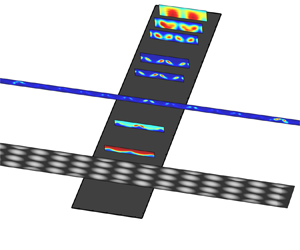Article contents
Transition induced by an egg-crate roughness on a flat plate in supersonic flow
Published online by Cambridge University Press: 09 September 2022
Abstract

Hot-wire measurements in a Mach 3.5 quiet tunnel were made in the wake of a roughness patch on a flat plate. These measurements were used to determine mode shapes and frequencies of the dominant instabilities leading to boundary-layer transition. The egg-crate roughness pattern is an analytic function described by a sinusoidal equation, similar to an array of discrete elements that are positioned in a spanwise and streamwise grid, but containing both protuberances and dimples. This is an intermediate configuration towards understanding the underlying physics of a pseudorandom distributed roughness, and ultimately, the underlying physics of roughness-induced boundary-layer transition. The roughness pattern had a wavelength of 6.25 mm, with a nominal amplitude of 272  ${\rm \mu}{\rm m}$ (0.49 times the boundary layer thickness at the first row of protuberances). The roughness was positioned near the leading edge of the flat plate and contained 3.5 wavelengths in the streamwise direction and 7.5 wavelengths in the spanwise direction. The dominant instability was centred near 74 kHz at a free stream unit Reynolds number of
${\rm \mu}{\rm m}$ (0.49 times the boundary layer thickness at the first row of protuberances). The roughness was positioned near the leading edge of the flat plate and contained 3.5 wavelengths in the streamwise direction and 7.5 wavelengths in the spanwise direction. The dominant instability was centred near 74 kHz at a free stream unit Reynolds number of  $12.9\times 10^{6}\,{\rm m}^{-1}$ and resembled an antisymmetric mode downstream of each of the protuberances in the roughness patch. Computations using linear stability analysis based on the plane-marching parabolized stability equations (PSE) showed limited agreement with measurements when comparing the growth of the wake instability. Better agreement with the measurements was observed when considering the modification of first mode waves by the egg-crate roughness patch and the solution of the three-dimensional harmonic linearized Navier–Stokes equations was used as the in-flow to the PSE. The agreement confirms the significance of disturbance growth both upstream of and above a finite length roughness patch and the effect on the growth of instabilities in the wake.
$12.9\times 10^{6}\,{\rm m}^{-1}$ and resembled an antisymmetric mode downstream of each of the protuberances in the roughness patch. Computations using linear stability analysis based on the plane-marching parabolized stability equations (PSE) showed limited agreement with measurements when comparing the growth of the wake instability. Better agreement with the measurements was observed when considering the modification of first mode waves by the egg-crate roughness patch and the solution of the three-dimensional harmonic linearized Navier–Stokes equations was used as the in-flow to the PSE. The agreement confirms the significance of disturbance growth both upstream of and above a finite length roughness patch and the effect on the growth of instabilities in the wake.
- Type
- JFM Papers
- Information
- Creative Commons
- To the extent this is a work of the US Government, it is not subject to copyright protection within the United States. Published by Cambridge University Press
- Copyright
- © National Aeronautics and Space Administration, 2022.
References
- 2
- Cited by





